
Flagstaff, Arizona
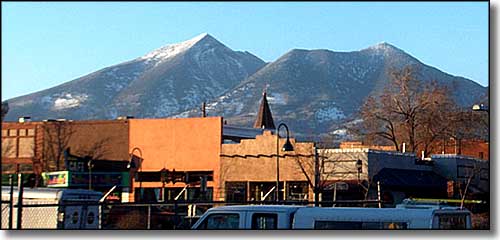
The Kachina Peaks rising above downtown Flagstaff
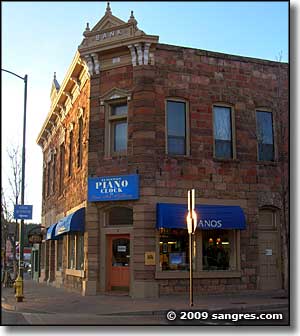
Flagstaff is the gateway to the Grand Canyon and the San Francisco Peaks region. Located near the southwestern edge of the Colorado Plateau, Flagstaff has often been one of those names on "Ten Best Places to Live" lists. The Arizona Snowbowl and the Flagstaff Nordic Center ski areas are nearby, too.
Even though Lt. Edward Fitzgerald Beale camped near here during his 1855 surveying journey along the 35th Parallel, Flagstaff didn't have a permanent resident until Thomas F. McMillan built his cabin at the foot of Mars Hill on what is now the west side of town in 1876. In the early 1880's, the railroad came through, following Beale's wagon road. That was when the first post office was opened. In those early days, Flagstaff was a center for sheep and cattle ranching and for railroad and big timber operations. By 1886, Flagstaff was the biggest city on the railroad line between Los Angeles and Albuquerque.
In 1896, Percival Lowell finished the installation of a 24-inch Clark Telescope in the Lowell Observatory atop Mars Hill. It was one of the telescopes at Lowell Observatory that was used in the discovery of Pluto in 1930. The Clark Telescope was also used in the 1960's during the Apollo program to map the lunar surface and choose where to land. Today, the Lowell Observatory is working with the Discovery Channel in a $30 million project to build the Discovery Channel Telescope, a ground-based telescope with advanced optical capabilities. Lowell Observatory also has a series of smaller telescopes that are networked together to create much higher resolution images of celestial bodies than any single telescope can produce. Astronomy's contribution to the reputation of Flagstaff has led to the Flagstaff City Council passing resolutions over the years to keep light pollution to a minimum and preserve Flagstaff's internationally recognized dark skies.
In 1899, the Northern Arizona Normal School was established. In 1966, this was renamed Northern Arizona University. On April 11, 1899, the Flagstaff Symphony Orchestra made their debut at Babbitt's Opera House. Today, the primary venue of the Symphony is the Ardrey Auditorium on the campus of Northern Arizona University. Flagstaff drafted a new master plan in 1987 that has turned the downtown area into a regional center for government, finance and corporate offices. Coconino County built a new administrative center downtown while Flagstaff built a new library and city hall in the same area. With a focus on maintaining the historical appeal of downtown Flagstaff, city sidewalks were repaved with decorative bricks and a new, more eclectic mix of restaurants and shops opened, revitalizing that formerly decaying (and slowly being abandoned) shopping and trade center. Flagstaff is also home to several active theatrical and dance companies, in addition to hosting annual book and film festivals, the Arizona Highland Celtic Festival, the "Made in the Shade" Beer-Tasting Festival, the Coconino County Fair and the Navajo and Hopi Festivals of Arts and Crafts.
These days, the economy of Flagstaff is driven mostly by tourism, educational services, transportation services and government. There is also a high number of scientific and research-and-development operations located in the city. SCA Tissue, W.L. Gore & Associates (makers of Gore-Tex), Nestlé Purina PetCare and Joy Cone (ice cream cone manufacturers) all have manufacturing facilities in Flagstaff. Walgreens located one of their major distribution centers here. The very first Ramada Inn (of the famous chain) was opened in Flagstaff back in 1954, although that venerable structure is now a Super 8 Motel.

Flagstaff City Hall
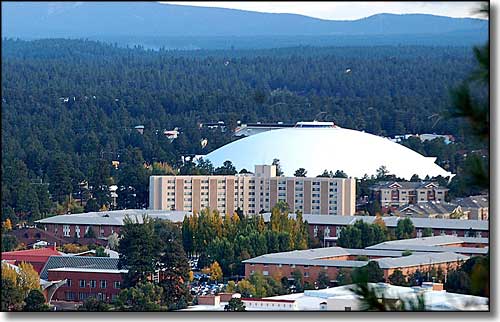
Northern Arizona University Skydome
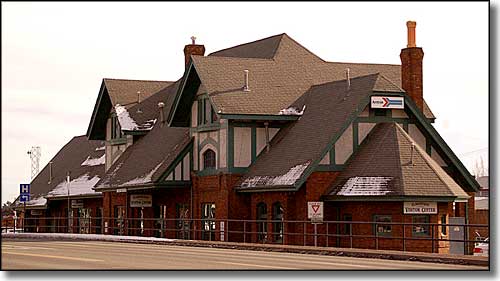
Flagstaff Train Station, now the AmTrak Station

In the downtown historic district
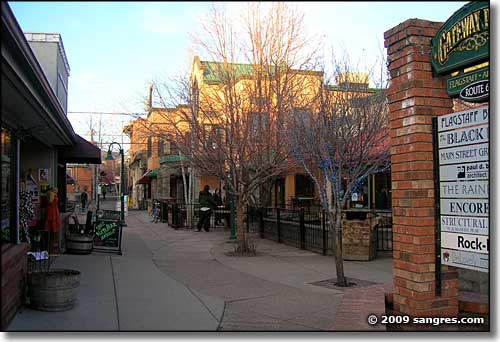
The pedestrian mall in the historic district of Flagstaff
Zip Codes: 86001-86004, 86011
Latitude: 35.2°N
Longitude: 111.658°W
Incorporated: 1928
Elevation: 6,910'
Education:
High School or Higher: 89.8%
Bachelor's Degree or Higher: 39.4%
Graduate or Professional Degree: 15.1%
2011 Cost of Living Index for Flagstaff: 97.8
Estimated Median Household Income: $49,900
Estimated Median Home Value: $290,700
Median Resident Age: 26.8 Years
Population Density: 953 People per Square Mile
Major Industries:
Educational Services, Lodging & Food Services, Health Care, Construction, Government, Social Services, Professional Services, Arts & Entertainment, Retail Services
Unemployed (March 2011): 5.9%
2010 Population Demographics
| Total Population | 65,870 |
| Males | 32,518 |
| Females | 33,352 |
| Population by Age | |
| Under 18 | 13,555 |
| 18 & over | 52,315 |
| 20-24 | 11,495 |
| 25-34 | 10,262 |
| 35-49 | 10,902 |
| 50-64 | 9,675 |
| 65 & over | 4,233 |
| Population by Ethnicity | |
| Hispanic or Latino | 12,094 |
| Non Hispanic or Latino | 53,776 |
| Population by Race | |
| White | 48,348 |
| African-American | 1,278 |
| Asian | 1,227 |
| Native American | 7,704 |
| Hawaiian or Pacific Islander | 115 |
| Other | 4,823 |
| Two or more | 2,375 |
